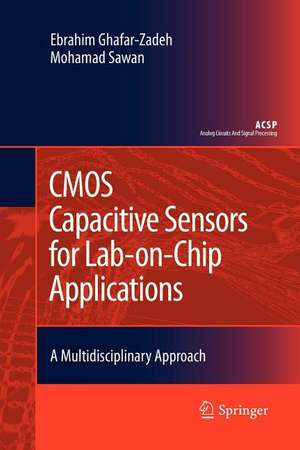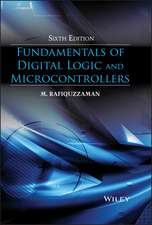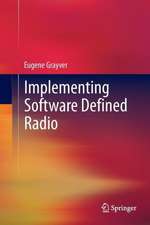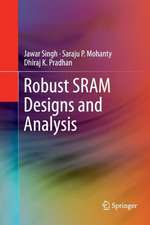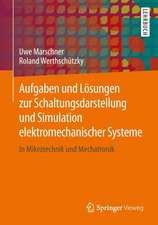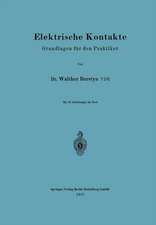CMOS Capacitive Sensors for Lab-on-Chip Applications: A Multidisciplinary Approach: Analog Circuits and Signal Processing
Autor Ebrahim Ghafar-Zadeh, Mohamad Sawanen Limba Engleză Paperback – 5 mai 2012
| Toate formatele și edițiile | Preț | Express |
|---|---|---|
| Paperback (1) | 633.68 lei 6-8 săpt. | |
| SPRINGER NETHERLANDS – 5 mai 2012 | 633.68 lei 6-8 săpt. | |
| Hardback (1) | 639.73 lei 6-8 săpt. | |
| SPRINGER NETHERLANDS – 22 mar 2010 | 639.73 lei 6-8 săpt. |
Din seria Analog Circuits and Signal Processing
- 5%
 Preț: 902.97 lei
Preț: 902.97 lei - 9%
 Preț: 629.00 lei
Preț: 629.00 lei -
 Preț: 388.34 lei
Preț: 388.34 lei - 15%
 Preț: 636.30 lei
Preț: 636.30 lei - 15%
 Preț: 636.80 lei
Preț: 636.80 lei - 18%
 Preț: 941.82 lei
Preț: 941.82 lei - 15%
 Preț: 639.08 lei
Preț: 639.08 lei - 18%
 Preț: 918.48 lei
Preț: 918.48 lei - 15%
 Preț: 631.21 lei
Preț: 631.21 lei - 15%
 Preț: 642.03 lei
Preț: 642.03 lei - 15%
 Preț: 641.85 lei
Preț: 641.85 lei - 18%
 Preț: 887.05 lei
Preț: 887.05 lei - 18%
 Preț: 944.51 lei
Preț: 944.51 lei - 15%
 Preț: 632.55 lei
Preț: 632.55 lei - 15%
 Preț: 641.03 lei
Preț: 641.03 lei - 18%
 Preț: 836.39 lei
Preț: 836.39 lei - 15%
 Preț: 642.18 lei
Preț: 642.18 lei - 15%
 Preț: 639.90 lei
Preț: 639.90 lei - 18%
 Preț: 947.85 lei
Preț: 947.85 lei - 15%
 Preț: 642.51 lei
Preț: 642.51 lei - 15%
 Preț: 631.86 lei
Preț: 631.86 lei - 15%
 Preț: 634.49 lei
Preț: 634.49 lei - 15%
 Preț: 635.47 lei
Preț: 635.47 lei - 15%
 Preț: 640.06 lei
Preț: 640.06 lei - 15%
 Preț: 631.53 lei
Preț: 631.53 lei - 15%
 Preț: 635.65 lei
Preț: 635.65 lei - 18%
 Preț: 941.50 lei
Preț: 941.50 lei - 18%
 Preț: 1112.92 lei
Preț: 1112.92 lei - 15%
 Preț: 636.30 lei
Preț: 636.30 lei - 15%
 Preț: 633.19 lei
Preț: 633.19 lei - 15%
 Preț: 635.80 lei
Preț: 635.80 lei - 18%
 Preț: 888.01 lei
Preț: 888.01 lei - 18%
 Preț: 942.76 lei
Preț: 942.76 lei - 18%
 Preț: 1387.10 lei
Preț: 1387.10 lei - 18%
 Preț: 1115.28 lei
Preț: 1115.28 lei - 15%
 Preț: 633.68 lei
Preț: 633.68 lei - 15%
 Preț: 641.03 lei
Preț: 641.03 lei - 15%
 Preț: 638.57 lei
Preț: 638.57 lei - 15%
 Preț: 642.51 lei
Preț: 642.51 lei - 18%
 Preț: 947.85 lei
Preț: 947.85 lei - 15%
 Preț: 640.71 lei
Preț: 640.71 lei - 15%
 Preț: 640.88 lei
Preț: 640.88 lei - 15%
 Preț: 631.40 lei
Preț: 631.40 lei - 18%
 Preț: 944.19 lei
Preț: 944.19 lei - 18%
 Preț: 944.67 lei
Preț: 944.67 lei - 18%
 Preț: 942.94 lei
Preț: 942.94 lei - 15%
 Preț: 641.20 lei
Preț: 641.20 lei - 20%
 Preț: 555.53 lei
Preț: 555.53 lei - 18%
 Preț: 1003.38 lei
Preț: 1003.38 lei
Preț: 633.68 lei
Preț vechi: 745.50 lei
-15% Nou
Puncte Express: 951
Preț estimativ în valută:
121.27€ • 126.14$ • 100.12£
121.27€ • 126.14$ • 100.12£
Carte tipărită la comandă
Livrare economică 14-28 aprilie
Preluare comenzi: 021 569.72.76
Specificații
ISBN-13: 9789400731806
ISBN-10: 9400731809
Pagini: 156
Ilustrații: X, 146 p.
Dimensiuni: 155 x 235 x 8 mm
Greutate: 0.23 kg
Ediția:2010
Editura: SPRINGER NETHERLANDS
Colecția Springer
Seria Analog Circuits and Signal Processing
Locul publicării:Dordrecht, Netherlands
ISBN-10: 9400731809
Pagini: 156
Ilustrații: X, 146 p.
Dimensiuni: 155 x 235 x 8 mm
Greutate: 0.23 kg
Ediția:2010
Editura: SPRINGER NETHERLANDS
Colecția Springer
Seria Analog Circuits and Signal Processing
Locul publicării:Dordrecht, Netherlands
Public țintă
ResearchCuprins
1: Introduction. 1.1 Overview of Lab-on-Chip. 1.2 From Macro to Micro Bioassays. 1.3 CMOS-Based Lab-on-Chips. 1.4 Objectives and Organization of book.
2: CMOS sensing electrodes. 2.1 On-chip microelectrode configurations. 2.2 Micromachining gold electrode on CMOS chip. 2.3 Electrical model of capacitive sensing electrodes. 2.4 Summary.
3: Capacitive Biochemical Interfaces. 3.1 Biochemical capacitive sensing methods. 3.2 Design of recognition element: An example for CGM. 3.3 Summary.
4: Capacitive Interface circuits. 4.1 LBCS vs. MBCS. 4.2 LBCS methods. 4.3 Core-CBCM interface circuit. 4.4 Core-CBCM ?? capacitive sensor. 4.5 Core-CBCM capacitive sensing system. 4.6 Summary.
5: Microfluidic Packaging Techniques. 5.1 Microfluidic packaging methods. 5.2 Direct-write microfabrication process. 5.3 Direct-write microfluidic packaging procedure. 5.4 Emerging applications of DWFP. 5.5 Summary.
6: Present and Future Technology of Capacitive Biosensors. 6.1 Conventional impedometric and capacitive measurement systems. 6.2 Handheld impedance measurement systems. 6.3 Towards fully integrated capacitive sensing LoC. 6.4 Summary.
2: CMOS sensing electrodes. 2.1 On-chip microelectrode configurations. 2.2 Micromachining gold electrode on CMOS chip. 2.3 Electrical model of capacitive sensing electrodes. 2.4 Summary.
3: Capacitive Biochemical Interfaces. 3.1 Biochemical capacitive sensing methods. 3.2 Design of recognition element: An example for CGM. 3.3 Summary.
4: Capacitive Interface circuits. 4.1 LBCS vs. MBCS. 4.2 LBCS methods. 4.3 Core-CBCM interface circuit. 4.4 Core-CBCM ?? capacitive sensor. 4.5 Core-CBCM capacitive sensing system. 4.6 Summary.
5: Microfluidic Packaging Techniques. 5.1 Microfluidic packaging methods. 5.2 Direct-write microfabrication process. 5.3 Direct-write microfluidic packaging procedure. 5.4 Emerging applications of DWFP. 5.5 Summary.
6: Present and Future Technology of Capacitive Biosensors. 6.1 Conventional impedometric and capacitive measurement systems. 6.2 Handheld impedance measurement systems. 6.3 Towards fully integrated capacitive sensing LoC. 6.4 Summary.
Notă biografică
Ebrahim Ghafar-Zadeh received the BSc and MSc degrees in Electrical Engineering from KNT and Tehran Universities, Tehran, Iran, in 1992 and 1994, respectively. In 1994 he joints the electrical engineering department at SCU University, Ahvaz, Iran as faculty memeber. During 2004-2008, he pursued a PhD degree in electrical engineering at Ecole Polytechnique de Montreal, Canada. In January 2008 and September 2008, he received two fellowship award from NSERC Canada and ReSMiQ Quebec, Canada which allowed him to continue his research for fully integrated bacteria detection. The research interests of Dr. Ghafar-zadeh include the circuit and system design, implementation and packaging technologies for lab-on-chip applications.
Mohamad Sawan received his BSc in Electrical Engineering from Université Laval (1984), and MSc (1986) and PhD (1990) both in Electrical Engineering from Université de Sherbrooke. He then completed post-doctoral training at Montréal's McGill University in 1991, and in that same year, joined École Polytechnique de Montréal, where he is currently a Professor of Microelectronics. Dr. Sawan's scientific interests focus on the design and testing of mixed-signal (analog, digital and RF) circuits and systems; digital and analog signal processing; and the modelling, design, integration, assembly and validation of advanced wirelessly powered and controlled monitoring and measurement techniques. These topics are oriented toward biomedical implantable devices and telecommunications applications. Dr. Sawan is holder of the Canada Research Chair in Smart Medical Devices. He heads the Microsystems Strategic Alliance of Québec – ReSMiQ and is founder of the Eastern Canada Chapter of the IEEE-Solid State Circuits Society. He also founded the International IEEE-NEWCAS conference, co-founded the International Functional Electrical Stimulation Society, and founded the Polystim Neurotechnologies Laboratoryat Ecole Polytechnique. He is the editor of Springer mixed-signal letters, Chair of the IEEE Biomedical CAS (BioCAS) Technical Committee, and member of the Biotechnology Council representing the IEEE-CAS Society. He has been awarded seven patents. He received the Barbara Turnbull Award for spinal cord research, the Medal of Merit from the Lebanese President (2005), and the J.-A. Bombardier Award from the Association Francophone pour le savoir (ACFAS). Dr. Sawan is a Fellow of both the Canadian Academy of Engineering and the IEEE.
Mohamad Sawan received his BSc in Electrical Engineering from Université Laval (1984), and MSc (1986) and PhD (1990) both in Electrical Engineering from Université de Sherbrooke. He then completed post-doctoral training at Montréal's McGill University in 1991, and in that same year, joined École Polytechnique de Montréal, where he is currently a Professor of Microelectronics. Dr. Sawan's scientific interests focus on the design and testing of mixed-signal (analog, digital and RF) circuits and systems; digital and analog signal processing; and the modelling, design, integration, assembly and validation of advanced wirelessly powered and controlled monitoring and measurement techniques. These topics are oriented toward biomedical implantable devices and telecommunications applications. Dr. Sawan is holder of the Canada Research Chair in Smart Medical Devices. He heads the Microsystems Strategic Alliance of Québec – ReSMiQ and is founder of the Eastern Canada Chapter of the IEEE-Solid State Circuits Society. He also founded the International IEEE-NEWCAS conference, co-founded the International Functional Electrical Stimulation Society, and founded the Polystim Neurotechnologies Laboratoryat Ecole Polytechnique. He is the editor of Springer mixed-signal letters, Chair of the IEEE Biomedical CAS (BioCAS) Technical Committee, and member of the Biotechnology Council representing the IEEE-CAS Society. He has been awarded seven patents. He received the Barbara Turnbull Award for spinal cord research, the Medal of Merit from the Lebanese President (2005), and the J.-A. Bombardier Award from the Association Francophone pour le savoir (ACFAS). Dr. Sawan is a Fellow of both the Canadian Academy of Engineering and the IEEE.
Textul de pe ultima copertă
Laboratory-on-Chip (LoC) is a multidisciplinary approach toward the miniaturization, integration and automation of biological assays. A biological laboratory contains various pieces of equipment used for performing a variety of biological protocols. The engineering aspect of LoC design is aiming to embed all these components in a single chip for single-purpose applications. LoC is a young discipline which is expected to subsequently expand over the next few years, stimulated by considerable development of applications in the mechanical, biochemical and electrical engineering domains. Among various microelectronic devices employed for LoC applications, CMOS capacitive sensors have received a significant interest for several applications including DNA detection, antibody-antigen recognition and bacteria growth monitoring. The main components of CMOS capacitive biosensors including sensing electrodes, bio-functionalized sensing layer, interface circuitries and microfluidic packaging are verbosely explained in chapters 2-6 after a brief introduction on CMOS based LoCs in Chapter 1. CMOS Capacitive Sensors for Lab-on-Chip Applications is written in a simple pedagogical way. It emphasises practical aspects of fully integrated CMOS biosensors rather than mathematical calculations and theoretical details. By using CMOS Capacitive Sensors for Lab-on-Chip Applications, the reader will have circuit design methodologies, main important biological capacitive interfaces and the required microfluidic fabrication procedures to create capacitive biosensor through standard CMOS process.
Caracteristici
This unique multidisciplinary book describes all the required components for the design of a CMOS capacitive biosensor It offers an extensive recent review of literature on using CMOS processes for Lab-on-Chip applications It emphasis on practical aspects of fully integrated capacitive biosensors Includes supplementary material: sn.pub/extras
